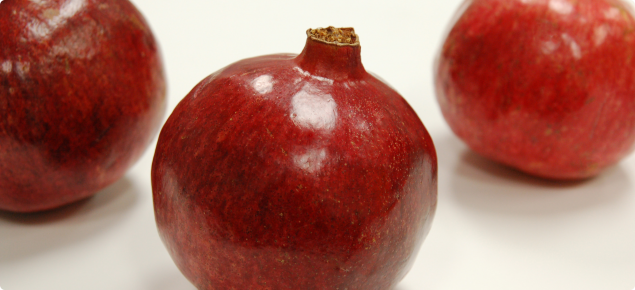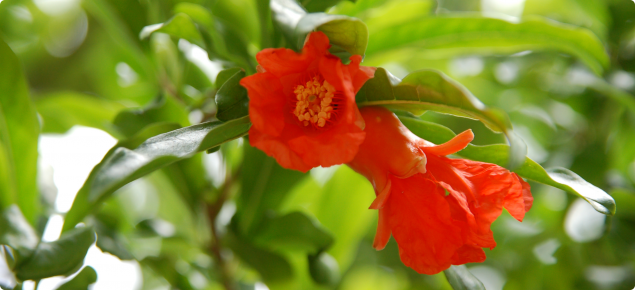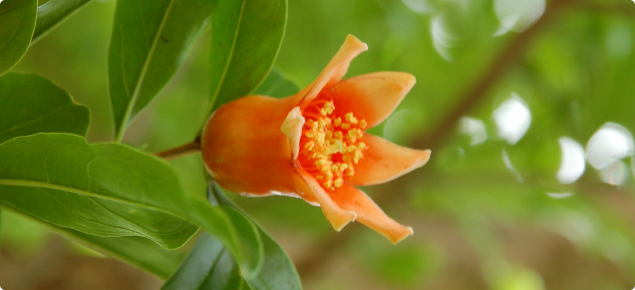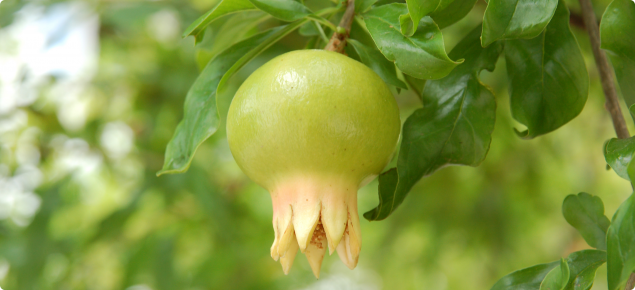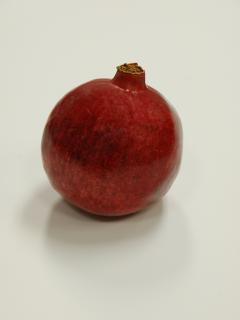Introduction
The round red fruit of pomegranate is a false berry. It consists of many close-packed red grains (arils), and segments which are separated by a non-edible white pith. The arils contain a seed surrounded by an edible juicy pulp.The pomegranate (Punica granatum) is native to Iran through to north India. The main areas of world production are Turkey, Spain and California. The flowers, fruits and autumn foliage are ornamental and it is often planted in home gardens from Carnarvon southward.
At present, the pomegranate is commercially harvested on an insignificant scale in Western Australia. The main annual imports are from California in November and December.
Climate
Pomegranates would probably grow best commercially from Geraldton to Albany. They grow best in warm areas, with temperatures up to 38°C. In inland areas, temperatures can be high and fruits can suffer from sunburn. Rainfall in summer and early autumn should be low. Established plants will survive frosts to minus 10°C. Flowering occurs in late spring, when there are no frosts. Pomegranates do not like high humidity.
Soils
Soils can be variable, but must be well drained.
The pH (by the water system of measurement) should be 5.5 to 7.0, but the plant will grow well in slightly alkaline soils.
Varieties
There are many varieties, with a range of quality varying from very sweet (bland) to very acidic flavours and with soft seeds, medium hard seeds or hard seeds. The best quality pomegranates have a good balance of sugars and acidity, and soft seeds, which can be consumed with the pulp.
Pomegranate varieties were observed at Medina Research Centre in the 1990s. Fruit quality and comments are shown in the table but yields were not recorded.
| Variety | External appearance | Internal appearance/juiciness, acidity | Comments |
|---|---|---|---|
| Gulosha Azerbaijani | Large size, good external appearance (light pink/red skin) | Large red grains, juicy | Good variety |
| Gulosha Rosavaya | Large size, good external appearance (light pink skin) | Large, red grains, juicy | Best variety for combination of sweetness, acidity and external appearance |
| Wonderful | Medium size, claret red skin | More acidic than Gulosha Rosavaya, red grains | Next best to Gulosha varieties, but smaller and more acidic, most common variety in California, better for juicing |
| Victorian Giant | Large size, not very attractive skin | Grain is not highly coloured, not juicy, mild flavour | Poor variety |
| Berri | Large size, unattractive skin | Not juicy, too sweet, bland flavour | Poor variety |
| Veles | Medium size, squarish shape, pink-red skin | Juicy, rich flavour, but very acidic | May be suitable for processing |
| Griffith | Large size, claret red skin | Red grains, rich flavour, but slightly too acidic | Fairly good variety |
Planting material
Pomegranates are easily struck in potting mixture in July and early August from 20 to 30cm cuttings when the plants are dormant. Leave the top one to two buds exposed. The cuttings should be 6 to 12mm thick.
A range of varieties is available from Lewis Horticulture, telephone +61 (0)8 8380 9598, Box 798, Virginia, South Australia 5120.
Keep the plants in a sheltered position in a nursery and use a slow release, complete fertiliser. Plant in spring, 13 to 15 months later, when the plants are 60 to 100cm high.
Field management
Incorporate compost into the hole before planting.
In early spring, plant in rows that ideally run east west. Space at 4 to 6m by 2 to 6m. Plants bear fruit on the terminal shoots of branches which receive good light. Production will decrease if spacing is too close and the branches are shaded due to the intermingling of branches from adjacent bushes.
Mulch plants with compost and/or organic material and apply occasional light applications of an organic manure for at least the first three years.
Wind protection is beneficial to ensure good growth. Permanent windbreaks of river sheoak (Casuarina cunninghamiana) will protect plants from winds, but sucker re-growth must be removed every year.
Fertilising
The fertiliser needs of the pomegranate are moderate compared with most fruit trees. For the first four years, apply a good, mixed fertiliser each month from August to March. One suitable commercial product contains 15% N, 2.2% P, 16.6% K, 1.2% Mg, 8% S and six trace elements. Apply a total of 0.5kg per tree in year 1, 0.75kg in year 2, 1kg in year 3, 1.5kg in year 4, 2.5kg in year 5 and 3kg from year 6 onwards.
Extra applications of zinc sulphate at 2g/L may need to be sprayed onto plants grown on alkaline sandy soils. Extra manganese and iron sprays may also be needed.
A leaf analysis from a proprietary laboratory will give a guide whether the nutrients in the leaves are at deficient, satisfactory, optimum, high or toxic levels. The results must be compared with other fruit trees, as there are no comparable standards for pomegranates.
Irrigation
The pomegranate has good drought tolerance, however for commercial production in Western Australia irrigation is required. Mature plants with mini-sprinklers or drip irrigation need about 5000 to 8000kL of irrigation water per hectare per year, with most applied from September to April.
Pomegranates have a higher salt tolerance than most fruit crops. The water quality should be less than 1000ppm total soluble salts for best results, but plants will tolerate more than 2000ppm total soluble salts.
Pruning
Shrubs are initially pruned at 60cm high to form three or four main stems. For the first three years, in winter, cut back slightly the tips of new shoots, to promote the development of side shoots. Remove suckers and water shoots, especially at the base of the stem. In winter, remove crossing branches.
Pests and diseases
Pomegranates have few pest and disease problems.
Mediterranean fruit fly occasionally causes damage where the fruit is cracked and a baiting program may be needed. The presence of this pest in Western Australia means that whole fruit cannot be exported to countries where this pest is not found.
Aphids can result in a twisting of young shoots and leaves. Scale insects can damage the leaves and stems.
Parrots will attack the fruit if the shell is cracked.
Rats can damage the fruit.
Root-knot nematodes can damage the roots.
Heart rot is often found in parts of the fruit and this is not obvious until the fruit is opened. It is believed to be caused by the fungal pathogen, Alternaria sp. which initially attacks the flower. It is difficult to control.
Weeds
Mowing or spraying to manage weeds is preferred to cultivation in older plantings to avoid root damage. Planting or a cover crop mixture of legumes and grasses in the inter-row is advisable to manage weeds and improve soil structure.
In the plant rows, apply glyphosate around the bushes, but avoid spray drift onto the leaves of the bushes, especially with young plants. This is a contact, non residual, herbicide that will kill most existing weeds. For grass control , use grass specific herbicides that are regisiteed to control existing weeds. Check the Australian Pesticides and Veterinary Medicines Authority's (APVMA) PubCris and minor use permit databases for pesticides that are registered or covered by a minor use permit to allow use on pomegranates in Western Australia. (see link on this page).
Fruiting
Pomegranates have attractive flowers which bloom for a long time from late spring to summer. Flowers occur on spurs of two to three-year wood and also on new wood.
Pomegranates are self- and cross-pollinated.
The fruit is a false berry. It consists of many close-packed red grains (arils), and segments which are separated by a non-edible white pith. The arils contain a seed surrounded by an edible juicy pulp. Fruit consists of 78% water, 8–21% sugars, 1.3% protein, 0.9% fat and 0.3–0.5% acid.
Plants do not commence to bear well until the third to fourth year after planting. Fruit matures from March to May.
Fruit is easily bruised and should be carefully handled. It will crack when too mature, or if there is too much rainfall in autumn, high humidities, poor watering, or high winds.
Pick the fruit with clippers, just before before the fruit has started to crack. The fruit should make a metallic sound when tapped. Clip the stem close to the fruit. The fruit will not ripen off the bush. Mechanical harvesters are not available for pomegranates.
Yields are 10 to 20t/ha, with 100 to 200 fruits per plant.
Pomegranates will store for about one or two months at ambient temperatures, or keep for seven months at 0–5°C and 80–85% relative humidity. The fruit improves in storage, becoming juicier and more flavoursome
Pomegranate bushes are long-lived.
Uses
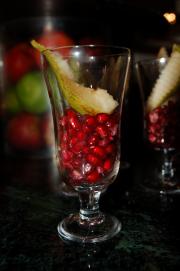
Pomegranates contain a high level of polyphenols or anti-oxidants and are now being promoted as a health food, especially for the juice market.
Overseas, pomegranates are often marketed not as whole fruit as in Australia, but as arils or juice.
Machines are available from Israel to remove the arils and process 16 pomegranates per minute with only a low level of damaged arils. Fruit is held in cool storage before the arils are extracted. With vacuum packaging, arils can be stored for six months.
Pomegranate juice can easily be extracted from the separated arils. There are existing markets for juice locally and internationally. Juice content of fruit ranges from 45 to 65%.
The juice is also used to produce grenadine, which is used in cocktails and to produce wine. Grenadine was traditionally a mixture of pomegranate juice, water and sugar, but modern versions may be based on corn syrup and artificial colourings. After extraction of juice, the waste material can be used for pharmaceuticals and cosmetics.
Acknowledgement
This article is based an an earlier version prepared by John Burt.

